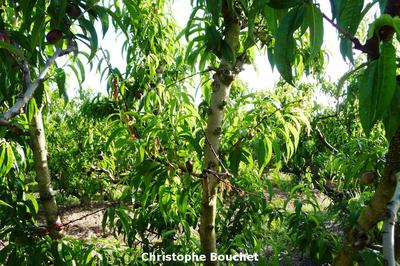Twig Canker of Peach
Phomopsis amygdali
శీలీంధ్రం
క్లుప్తంగా
- Wilting and drying of foliar blades on infected twigs.
- Gum formation on the bark and shoot vascular tissues.
- Shriveling and premature dropping of fruits.
లో కూడా చూడవచ్చు
లక్షణాలు
The symptoms of constriction canker caused by Fusicoccum amygdali are most often observed in early spring following bud break. They start to appear on new shoots 2 to 15 days after infection. Some twigs and shoots show wilting leaves and blossoms that progressively start to dry and turn brown (blight). Gum forms and exudes from the bark of the affected twigs, usually around the nodes. The gummosis later extends to the vascular tissues within the shoots or twigs. An elongate, brown, diffuse and sunken cankers appears at the base of the shoots, often surrounded by a concentric pattern. The bark of the shoot tissues hardens, a process called suberosis. Most fruit on infected shoots shrivel and drop off as the shoots desiccate.
సిఫార్సులు

సేంద్రీయ నియంత్రణ
Organic products based on different species of Trichoderma can significantly reduce the growth of F. amygdali if applied in a timely manner. Copper compounds can also be used as sprays once the disease has been detected.

రసాయన నియంత్రణ
Always consider an integrated approach with preventive measures together with biological treatments if available. Fungicidal sprays containing the active ingredients methyl-thiophanate, have been proven very effective in controlling the constriction canker of peach.
దీనికి కారణమేమిటి?
The pathogen can infect almond and peach twigs either through leaf wounds in fall and bud scale scars, blossoms, and fruit scars in spring. However, direct infection through dormant buds is also possible. Symptoms appear in early summer and become increasingly evident as more blighted shoots appear during the season. The actual symptoms (constriction of shoots, gummosis and suberosis of bark, wilting and blight of leaves and blossoms) are not produced by the growth of the fungus but the production of a toxin named fusicoccin that is transported via the vascular tissues to the rest of the twigs.
నివారణా చర్యలు
- Chose resistant varieties, if available in the area.
- Monitor the orchard regularly for symptoms of the disease.
- Remove severely infected twigs and shoots and destroy them far away from the orchard (by deep burying or burning).
- Cut branches a few centimeters from infected areas.


